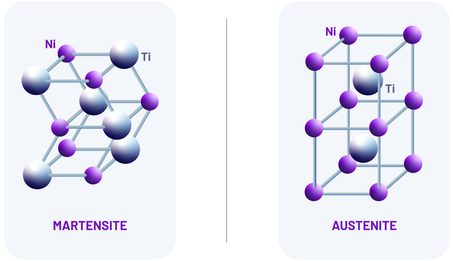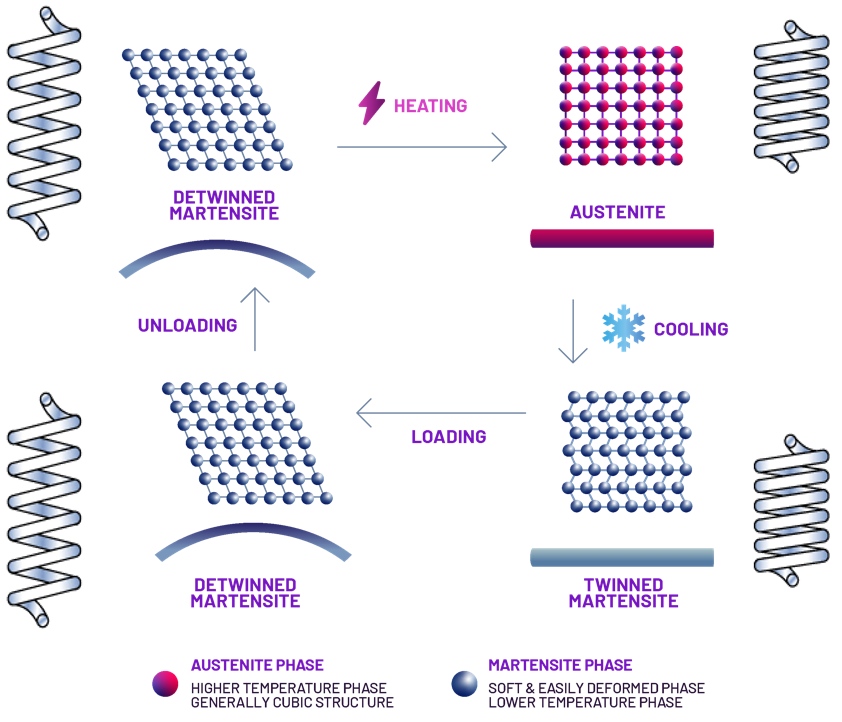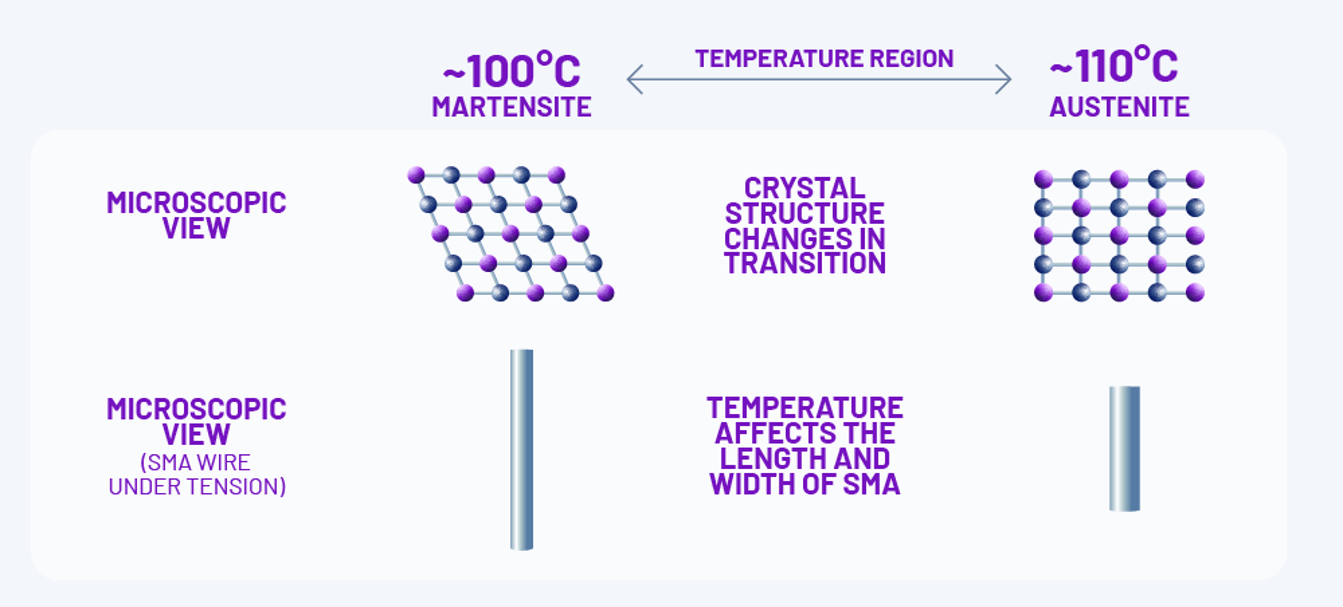13 Sep 2023
Shape Memory Alloy – unveiling the material properties
By Bronwen Derry, Director of SMA Technology
Shape Memory Alloys (SMAs) have captivated the attention of engineers and scientists alike due to their unique super-elastic and shape memory effect properties. One of the most widely recognized of these alloys is Nitinol, and its attributes make it a material of choice in numerous applications, particularly in actuation systems.
Nitinol is made up of 50% Nickel and 50% Titanium. Apart from its superelasticity, Nitinol's shape memory effect means it is highly coveted across a multitude of industries. In this article, we explain the shape memory effect and what makes SMA so special.
At its core, the shape memory effect of Nitinol is a phenomenon that allows the alloy to "remember" its original shape. This means that the material can be deformed or stretched and it can regain its initial shape when subjected to specific heat and stress conditions. This exceptional characteristic is a product of the underlying phase transformations that Nitinol undergoes.
The austenitic and martensitic phases
The behaviour of Nitinol and its ability to transition between shapes can be traced back to its microscopic crystalline structures, chiefly the austenitic and martensitic phases.

In its higher-temperature or "hot" state, Nitinol is in the austenitic phase. In this phase, the atoms are arranged in an ordered, compact manner, resulting in a crystalline structure known as austenite. This structure is robust and resilient, giving Nitinol its superelastic properties.
However, as Nitinol cools down, this orderly structure starts to transition into the martensitic phase. Here, the atoms rearrange into what is known as a "twinned" structure. This twinned martensitic structure is more flexible, permitting the alloy to undergo significant deformation without permanent alteration.
When deformed in its martensitic state, the twinned structure evolves into a detwinned structure, accommodating the external stress or strain. Yet, the material does not forget its original austenitic structure. When reheated, the detwinned martensitic structure transitions back to its austenitic phase. It's during this transformation that the shape memory effect becomes apparent, with Nitinol reclaiming its original shape. These phase transformations are reversible.

How CML uses SMA for miniature actuators
Cambridge Mechatronics Ltd. (CML) has harnessed the potential of SMA by utilizing it in the form of thin Nitinol wires to build miniature actuators for compact consumer electronics products, such as smartphone cameras or VR displays. The wires are thinner than a human hair and when they are electrically heated above the transition temperature they contract. The actuators are designed to use approximately +/-1% strain. This means that, for example, a 10-millimeter-long wire offers +/-100 microns of stroke (200 microns total).
Despite the wires being very thin, they offer tremendous force-to-weight ratio capability. A single SMA wire can easily lift masses of 50 grams or more. This property makes them capable of moving relatively heavy components in compact consumer electronics.
The length of the SMA wire – and by inference the position of the lens in an actuator – can be measured directly from the resistance of the SMA wire. CML is the only company that has developed closed-loop control using wire resistance.

SMA actuators stand out as a technology of choice due to the following properties and advantages:
- Compact & Lightweight: The SMA systems' small footprint makes it ideal for applications demanding space optimization without compromising on performance or functionality
- High-Force Capability: SMA wires have a very high force-to-weight ratio enabling fast and precise motion control for relatively heavy objects.
- No Magnetic Interference: Unlike voice coil motors (VCMs), SMA actuators don't produce electromagnetic interference (EMI), ensuring that they can be employed in environments sensitive to magnetic fields.
- Reliability: Over 50 million SMA actuators have shipped in >35 products. CML has a deep understanding of the design and control criteria to achieve tough reliability specifications.
- Low Voltage: SMA actuators can operate at low voltages and even at zero power consumption in some applications.
- Mass Production Viability: Given their consistent properties and scalability, SMA actuator are apt for large-scale manufacturing.
- Silent Operation: SMA actuators do not generate audible noise, indispensable when integrated into audio equipment like headsets or smartphones.
In summary, Nitinol's ability to "remember" its original shape and reversibly transition between its austenitic and martensitic phases enables its use in compact and precise actuators. This grants it a unique standing among materials.
CML is the only company that has developed closed-loop control for SMA actuators without the use of external position sensors. SMA actuators have found relevance in consumer electronics, delivering compact designs capable of a high force-to-weight ratio.
About CML: Cambridge Mechatronics Limited (CML) is a world-leading developer of mechanical, optical, electrical, silicon, and software designs for system-level solutions using its Shape Memory Alloy (SMA) platform technology. Actuator solutions based on SMA wire (thinner than human hair) can be controlled to submicron accuracy. These actuators are particularly suited to applications requiring high precision and force levels, in a fast, compact, and lightweight design.
For more details about SMA technology and Cambridge Mechatronics, please GET IN TOUCH.
